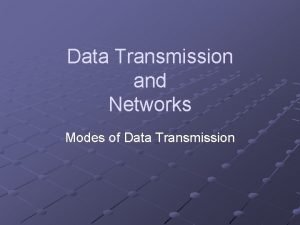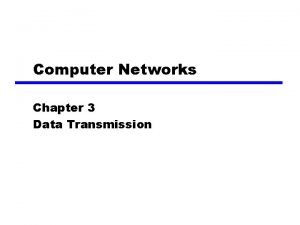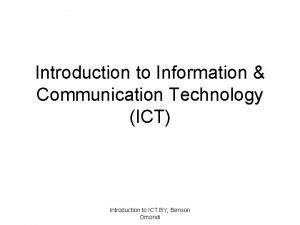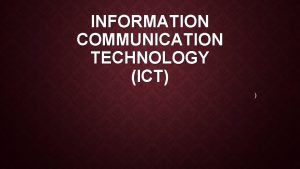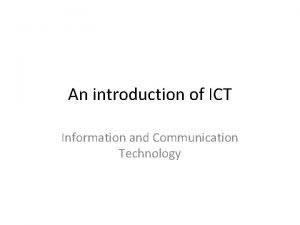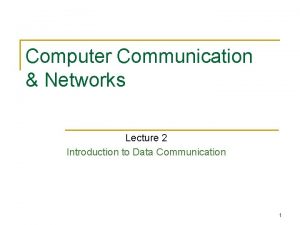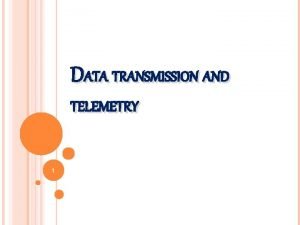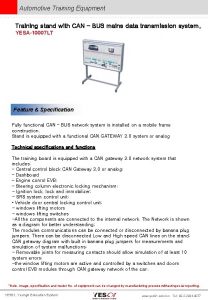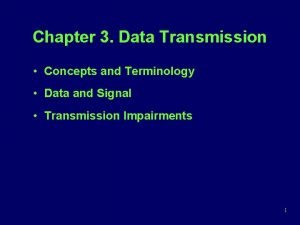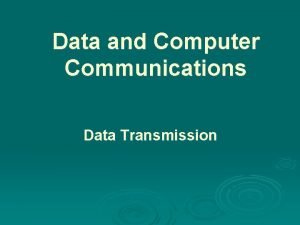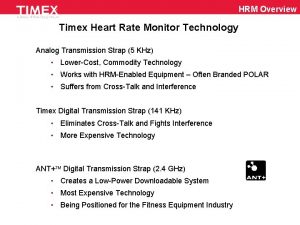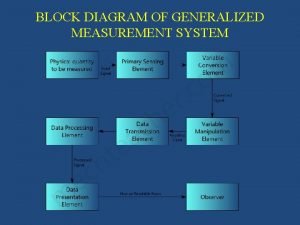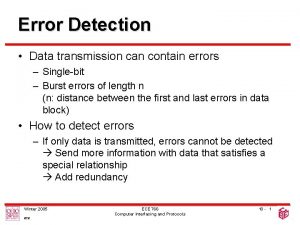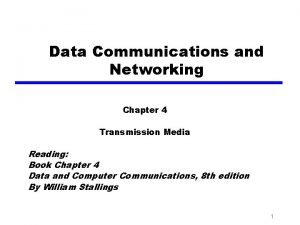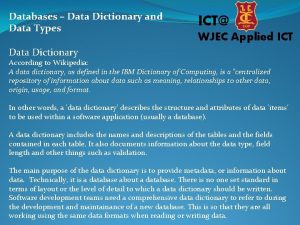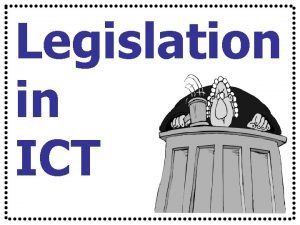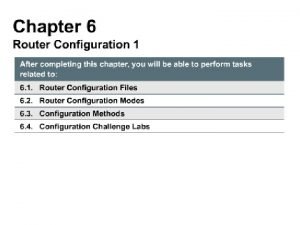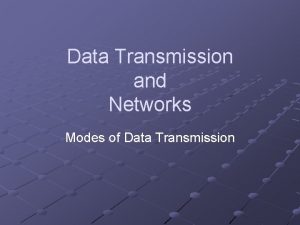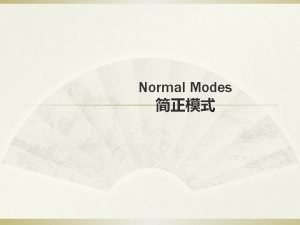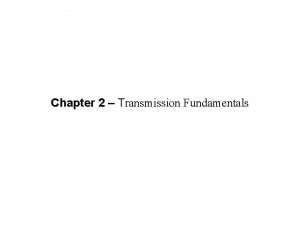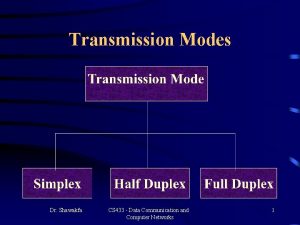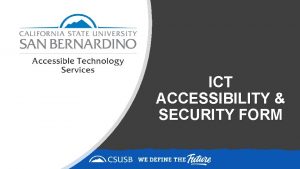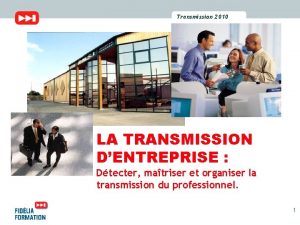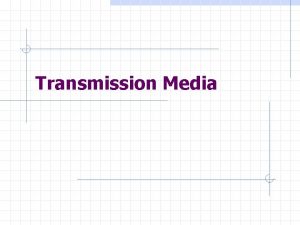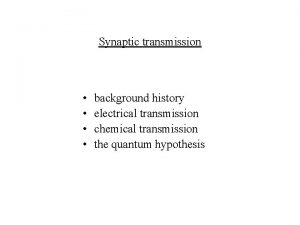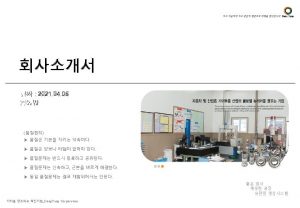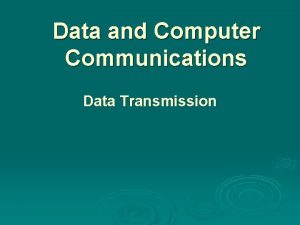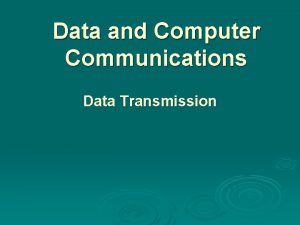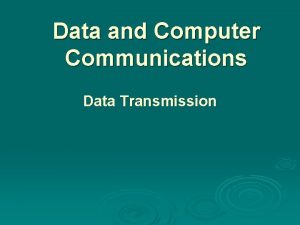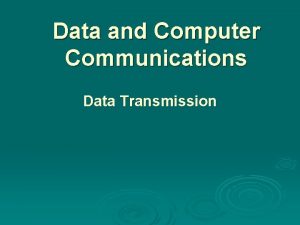Introduction to ICT Data communication Data transmission modes









































- Slides: 41

Introduction to ICT • • Data communication Data transmission modes Forms and types of data transmission Computer networks Types of computer networks Network architecture Wireless networks

Data communication • Data communication is a process of transferring data electronically from one place to another. • Basic elements of data communication are – Sending device – Receiving device – Communication device – Transmission medium

Data communication • Sending device is a device that sends message, it is also called source or transmitter. It can be a computer, fax machine, mobile phone etc. • Receiving device is a device that receives message, it is also called sink. It can be a computer, fax machine, mobile phone etc.

Data communication • Communication devices are used to transmit messages between sending and receiving devices through communication medium. Most commonly used communication devices are modem and network card. • Transmission medium is used to carry messages from one place to another, it is also called communication channel. Transmission medium can be a physical cable or wireless connection.

Data Transmission Modes • Data transmission mode is the way in which data is transmitted from one place to another. • There are three data transmission modes – Simplex mode – Half-Duplex traffic – Full-Duplex traffic

Data Transmission Modes • In simplex mode, data can flow only in one direction, it operates in a manner similar to a one way street. • The direction of flow never changes. • A device with simplex mode can either send or receive data. • An example is a traditional television broadcast.

Data Transmission Modes • In half-duplex mode, data can flow in both directions but not at the same time. • It is transmitted one way at a time. • A device with half-duplex mode can send or receive data but not at the same time resulting in a slow speed. • Internet surfing is an example of half-duplex communication.

Data Transmission Modes • In Full-Duplex mode, data can travel in both directions simultaneously. • Time is not wasted in changing the direction of data flow, making it a faster way of data transmission. • An telephone is a full-duplex device.

Data Transmission Modes

Forms of Data Transmission • An electromagnetic or light wave used to transmit data from one place to another is called a signal. • Propagation of signals across a communication medium is called signaling. • Communication of data from one place to another in the form of signal is called transmission.

Forms of Data Transmission • Two forms of data transmission are – Digital data transmission – Analog data transmission

Forms of Data Transmission • Digital data transmission – All data communication between the computers is in digital form. – Digital signal is a sequence of voltage represented in binary form. – They are in the form of electrical pulses of ON and OFF. – Digital signals are faster and efficient and provide low error rates.

Forms of Data Transmission • Analog data transmission – Analog signal is a continuous electrical signal in the form of a wave known as carrier wave. – Telephone line is most commonly used media for analog transmission of data. – Light, sound and microwave are some other examples.

Types of data transmission • Two types of data transmission are – Asynchronous transmission – Synchronous transmission

Types of data transmission • In asynchronous transmission, data is transmitted character by character. • There are irregular gaps between characters in this transmission. • It is cheaper to implement because data is not saved before it is sent.

Types of data transmission • In synchronous transmission, the saved data is transmitted block by block. • Each block may consist of many characters. • A large amount of information can be transmitted at a single time with this type of transmission. • It is much faster than asynchronous transmission because there is no gap between characters.

Computer Network • A computer network consists of two or more computers that are connected together through some communication media to share information and resources. • The communication media can be a cable or a wireless connection. • Connected computers can be in the same room, same building or at distant locations.

Computer Network

Computer Network: Examples • Computer networks can be used in an office. Different people in the office can access common information. They can share their files and exchange mail. They can also print documents from any computer in the network. • Internet is also an example of a computer network in which millions of computers are connected through phone lines. People using this network can share information, files and talk with one another.

Computer Network: Network Criteria • A network must meet a certain number of criteria. The most important criteria include performance, reliability and security. • Performance is measured in transit time and response time. Transit time is the time required for a message to travel from one device to another and response time is the time elapsed between an inquiry and the response.

Computer Network: Network Criteria • Reliability of a network is measured by different factors such as accuracy of data, frequency of failure and time taken to recover from failure. • Security is the protection of data from unauthorized access and damage. It also includes the implementation of procedures for data recovery if it is lost or damaged.

Computer Network: Advantages • • • Information and resource sharing Money saving Easy communication Internet access sharing Data security and management Entertainment

Computer Network: Disadvantages • • • Hardware and software setup costs Hardware and software management costs Undesirable sharing Illegal or undesirable behavior Data security concerns

Types of Computer Network • Different types of computer networks are – LAN - Local Area Network – WAN – Wide Area Network – PAN – Personal Area Network

Types of Computer Network: LAN • LAN stands for local area network and is the most common type of network. • It covers a small area and usually connects the computers and other devices within one office or a building or group of buildings. • It is often used to share resources such as printers, hard disks and programs. • Each computer or device in the network is called a node, and these nodes are usually connected though wires.

Types of Computer Network: LAN • A LAN that uses no wires is called a wireless LAN. • LAN can transmit data in a limited distance and number of computers that can be attached to the network is also limited. • LAN transmission speed is typically 10 Mbps to 1000 Mbps. • Example: In a computer lab, there are 40 computers connected through LAN. They can share software, files and data in the lab.

Types of Computer Network: WAN • WAN stands for wide area network. • It covers a large area and connects computers and other devices in different cities and countries. • WAN usually consists of several LANs connected together. • Computers in a WAN are often connected through telephone lines, but they can also be connected through leased lines or satellites.

Types of Computer Network: WAN • WAN is expensive than LAN and is not as fast as LAN. • Transmission rate is typically 56 Kbps to 50 Mbps. • Examples: – The network connecting the ATMs of a bank located in different cities. – The network connecting NADRA offices in different cities of Pakistan. – Internet connects millions of users all over the world to share information.

Types of Computer Network: PAN • PAN stands for personal area network. • It is a network that connects personal devices using wired and wireless technology within range of about 30 feet. • Devices may include portable computer, smart phones, digital cameras and printers etc. • PAN enables devices to communicate and share data.

Types of Computer Network: PAN • Wireless PANs are more common then wired PAN and use Bluetooth or Wi-Fi technology to connect devices. • Example: A PAN can be used – to sync data from a hand held device to a desktop computer. – Move data wirelessly to a printer. – Transmit data from a smartphone to a wireless headset.

LAN vs WAN

Network Architecture • Network architecture is the design of computers and other devices in a network and how they communicate. • The two most common network architectures are – Peer-to-peer (P 2 P) – Client-server

Network Architecture: Peer to Peer • Peer to Peer is a simple and inexpensive network and normally connects less than ten computers. • Each computer in the network stores files on its own storage devices and can share data and information of any computer in network. • The network operating system and application software installed on all computers. • P 2 P networks are suitable for small businesses and home users.

Network Architecture: Peer to Peer

Network Architecture: Client-Server • Client-server is a network in which one or more computers work as servers and other computers work as clients. • A Server is a computer that provides services to the computers and other devices connected to the network and is also known as host computer. • It is more powerful than other computers in the network and have more memory.

Network Architecture: Client-Server • Different services provided by the server are – – – Control access to hardware, software and data. Centralized storage for software, data and information Processing data Sharing software Managing network traffic • Some servers are known as dedicated servers because they perform a specific task. • For example a file server is used to store and manage files, print server is used to manage printers and network server is used to manage network traffic.

Network Architecture: Client-Server • A client is a computer in the network that is connected with a server to access different resources. • The client computer sends request to the server for resources. • The server computer provides the requested resource to the client computer. • Client computer is less powerful than server computer.

Network Architecture: Client-Server

Wireless networks • Wireless networks can be – Fixed wireless system – Mobile wireless system

Wireless networks • Fixed wireless system provides little or no mobility of the computing equipment used in wireless networks. • The equipment remains at the same position. • For example a LAN can be setup using wireless technology to avoid the use of cables.

Wireless networks • Mobile wireless system provides mobility of computing equipment used in wireless networks. • It also supports the mobility of users, so that mobile users can access information from anywhere and at any time. • The user does not need to maintain fixed position in the network. • Typical equipment used in mobile wireless systems are smart phones, personal digital assistant (PDA) and pagers with the internet access.
 Three modes of data transmission
Three modes of data transmission Transmission media in data communication
Transmission media in data communication Transmission terminology
Transmission terminology Taylor theory
Taylor theory Actfl proficiency levels chart
Actfl proficiency levels chart Transmission model of communication
Transmission model of communication Introduction of wireless power transmission
Introduction of wireless power transmission An act of transmitting messages
An act of transmitting messages Trends in ict assistive media
Trends in ict assistive media Introduction on ict
Introduction on ict Introduction of ict
Introduction of ict Introduction of ict
Introduction of ict Mode dma
Mode dma Modes of data collection
Modes of data collection Introduction to data communication
Introduction to data communication Telemetry system
Telemetry system Data encoding and transmission
Data encoding and transmission Automobile data transmission system can bus training stand
Automobile data transmission system can bus training stand Baseband binary data transmission system
Baseband binary data transmission system Data transmission concepts and terminology
Data transmission concepts and terminology Data transmission terminology
Data transmission terminology Amss chennai data transmission
Amss chennai data transmission Timex hrm
Timex hrm Block diagram of generalized measurement system
Block diagram of generalized measurement system Error in data transmission
Error in data transmission Data transmission media
Data transmission media Data types in ict
Data types in ict Validation check ict
Validation check ict Teach ict data protection act
Teach ict data protection act Data protection act 1998 ict
Data protection act 1998 ict Introduction to data mining and data warehousing
Introduction to data mining and data warehousing Cisco router modes
Cisco router modes Vga text buffer
Vga text buffer Indexed addressing mode in 8086
Indexed addressing mode in 8086 Addressing modes of 8086 microprocessor
Addressing modes of 8086 microprocessor Ano ang mode of discourse
Ano ang mode of discourse 4 modes of writing
4 modes of writing Immediate addressing mode
Immediate addressing mode Mintzberg's modes of strategic decision making
Mintzberg's modes of strategic decision making 22/60 powder means
22/60 powder means Compositional mode for social media
Compositional mode for social media Mode of ventilation
Mode of ventilation
